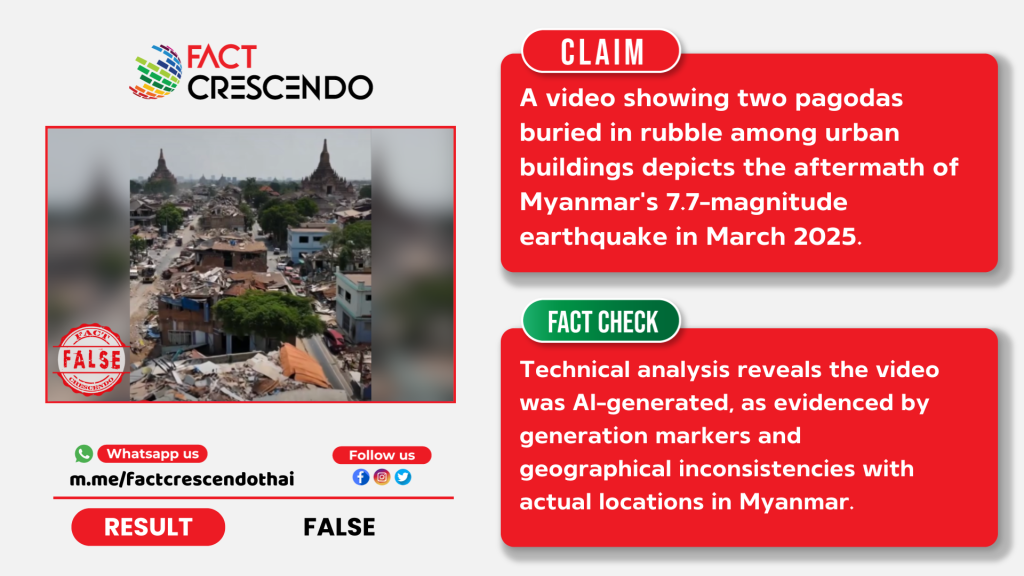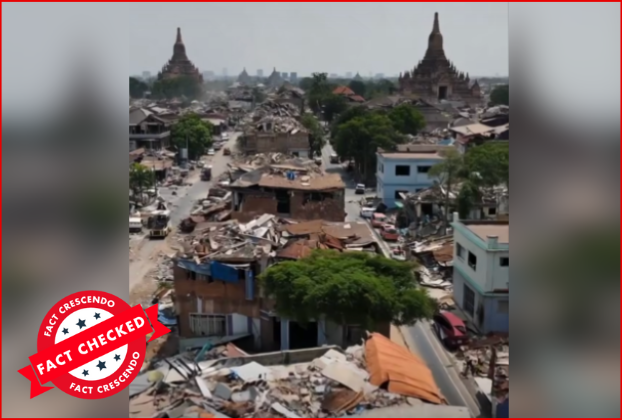
A video claiming to depict the aftermath of a devastating 7.7-magnitude earthquake in Myanmar has been circulating widely on social media platforms since March 28, 2025. The footage, filmed from a high vantage point, shows two pagodas buried in rubble amidst buildings flanked by two roads. With reports of widespread destruction in cities like Sagaing, Mandalay, and Nay Pyi Taw, and thousands of lives lost, this video has fueled speculation and concern.
Social Media Posts
The video purports to show the destruction from one of Myanmar’s most powerful earthquakes ever. It has spread rapidly across social media, with many viewers believing it shows actual footage from the disaster zone.
Fact Check
Analysis of the video reveals several aspects that require verification:
Geographical Inconsistencies
The video features two pagodas that resemble the iconic Bagan-era structures. However, Sagaing and Mandalay—the primary areas affected by the earthquake—do not have such pagodas in the urban settings shown. Bagan, a historical site famous for its ancient temples, lies outside the hardest-hit zones and does not match the background scenery in the footage.
Actual footage showing a pagoda in Mandalay after the earthquake, captured by INQUIRER.net
Lack of Local Media Coverage
We found that Major Burmese-language news outlets covering the earthquake’s aftermath have not included this video in their reporting, suggesting the need for further verification of its authenticity.
AI-Generated Indicators
Image Analysis: Using AI image detection tools, key frames from the video were analyzed, and the results strongly suggest the footage is artificially generated.
Source: Was it AI?
Length: At just 6 seconds, the video aligns with the typical output duration of many AI video generation platforms.
Watermark: An uncropped version of the footage (Source | Archive) reveals a “Wan” watermark. Wan AI is a known AI content creation tool that often embeds its signature on generated media, further supporting the likelihood of fabrication.
According to BBC journalist Shayan Sardarizadeh, the video was first posted by TikTok user “lee.meedia7”. Upon investigation, we found that the account has been deleted. This suggests the account was likely created specifically to spread misinformation, as deleting accounts after spreading false content is a common tactic used by those seeking to spread disinformation during crises.
Visual Anomalies
Uniformity: The two people visible in the video are the same color, and the cars are identical in color and style—unusual for a real-world scene. Moreover, the car designs don’t match vehicles commonly seen in Myanmar.
Inconsistent Damage: While the roofs of intact buildings are littered with debris, the structures beneath show no signs of damage. This defies typical earthquake patterns, where structural harm is more widespread.
Missing Features: Urban areas in Myanmar typically feature power lines and electricity poles, yet these are conspicuously absent from the video.
Conclusion
Based on our analysis, the viral video claiming to show the aftermath of Myanmar’s March 2025 earthquake presents several inconsistencies. The geographical features do not match known locations in the affected areas, and local media has not featured this footage in their coverage. Technical analysis reveals indicators consistent with AI-generated content, including a Wan watermark and certain visual elements that differ from typical scenes in Myanmar. Given these findings, this video appears to be computer-generated rather than actual documentation of the earthquake’s impact in Mandalay or other affected regions.

Title:Viral Video of Myanmar Earthquake Aftermath Revealed as AI-Generated
Fact Check By: Cielito WangResult: False






